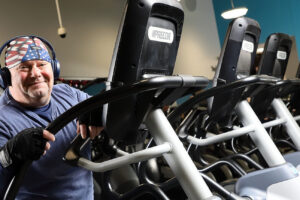Though Jersey City native Thomas Ryan, 58, had been living with diabetes for 30 years, he was faced with yet another health-related obstacle when he had to undergo amputation of four of the toes on his left foot at a hospital in Hoboken. A common side effect of diabetes, poor circulation in his legs left him with an infection and multiple foot wounds that wouldn’t heal—and Thomas was told his only option was leg amputation.
After moving to Freehold shortly after his surgery, Thomas ended up at the Central Jersey Wound Center at CentraState in search of additional treatment—and a second opinion. Anthony Fiorilli, DPM, a podiatrist on staff at CentraState, began treating the wounds on his foot—only to have new wounds develop and infection set in. “We had multiple issues to deal with because of Mr. Ryan’s diabetes and vascular disease, and I knew he would require the help of several specialists,” Dr. Fiorilli says.
Due to a particularly bad infection, Dr. Fiorilli ultimately had to amputate Thomas’s big toe on his left foot and more bone off of the other previously amputated toes, as well as amputate a toe on his right foot. “My goal was to prevent Mr. Ryan from having to lose his leg entirely and spend the rest of his life in a wheelchair,” he adds.
Thomas was also treated by Ramanasri Kudipudi, MD, board-certified infectious disease specialist and on staff at CentraState, who placed him on an aggressive course of antibiotics and, later, hyperbaric treatments for his infections.
“Though Mr. Ryan was a very good patient, it took our team approach at the wound center and the collaboration of podiatry, vascular, and infectious disease specialists to help heal his wounds,” she says.
According to Robert Kayser, MD, board certified interventional cardiologist with Change of Heart Cardiology and medical director of the endovascular division at CentraState, these days virtually all patients receive a vascular evaluation at the wound center. Ryan was referred to Dr. Kayser in an effort to improve his circulation and prevent further amputations. Dr. Kayser told Thomas that his options were to continue to clean and bandage the wounds while monitoring for possible reinfection, amputate the leg below the knee, or an angioplasty.
“I was so thankful to finally have some options, and felt it was best to put my trust in the doctor,” Thomas says.
Dr. Kayser used the latest interventional techniques and performed endovascular surgery using catheters to restore blood flow to Thomas’s legs. Through this approach, the amputation rate for patients like Thomas has decreased dramatically in recent years.
“Mr. Ryan’s foot clearly wasn’t going to heal until we improved blood flow into his leg, and I was able to open up a lot of arteries,” Dr. Kayser explains. “Nobody had ever taken this comprehensive approach to help heal his wounds—and it worked.”
After nearly two years of treatment at the Wound Center, Thomas recalls how the nurses and his wife, Connie, broke down in tears when doctors gave him the best news of all: his wounds had finally healed. “The doctors looked at me and told me it was all over, and I could go on living my life,” he says.
These days, Ryan loves nothing more than splashing around in the pool with his grand kids or attending baseball games.
“I’m doing great, and there’s no way I could ever thank the doctors, nurses, and technicians at the Wound Center enough for saving my leg and allowing me to enjoy life again,” he says.
For more information about the Central Jersey Wound Center at CentraState, call 866-CENTRA7 (866-236-8727).





